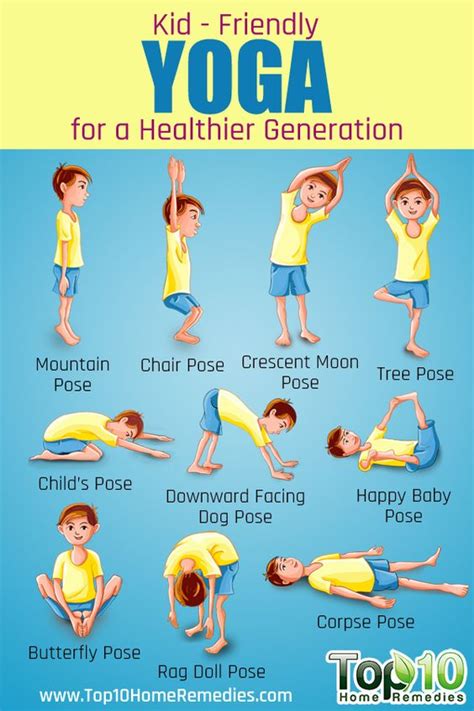Yoga for Children: 7 Engaging and Simple Poses to Keep Kids Active and Mindful
Yoga for children is becoming increasingly popular due to its numerous physical, emotional, and mental benefits. With a fun and easy approach, children can not only engage in physical exercise but also cultivate mindfulness, body awareness, and stress relief. These simple yoga poses make yoga accessible for children of all ages, ensuring they stay active and focused while having fun. In this article, we’ll explore 7 yoga poses that are ideal for kids, helping parents and teachers introduce the practice in an enjoyable and engaging way.
Introduction: Why Yoga is Beneficial for Children
Children today face an ever-increasing number of distractions and pressures. Yoga offers a balanced approach to mental and physical well-being, helping them develop strong, flexible bodies and calm, focused minds. Whether it’s learning patience, improving coordination, or simply reducing stress, the benefits of yoga are wide-ranging.
- Physical Benefits: Improved flexibility, strength, coordination, and balance.
- Mental Benefits: Increased focus, concentration, and relaxation.
- Emotional Benefits: Enhanced self-esteem, reduced anxiety, and emotional regulation.
Teaching yoga to children can also help them cultivate mindfulness and empathy for others, two key elements of a harmonious lifestyle. The following seven poses are designed to be fun and accessible, perfect for children to enjoy while learning how to tune into their bodies and minds.
Key Concepts: Child-Friendly Yoga Basics
To ensure that yoga is appropriate for children, it’s important to focus on the following principles:
- Simplicity: Keep the poses simple and accessible, avoiding complex movements that could lead to frustration.
- Fun Element: Engage kids with playful names for the poses and creative stories to accompany them.
- Body Awareness: Teach children how to move mindfully and listen to their bodies to prevent injury.
- Short Duration: Keep sessions short and energetic, allowing for natural breaks in concentration.
By incorporating these principles, yoga can become a joyful activity that kids look forward to, not just another task to complete.
Historical Context: Yoga’s Evolution and Adaptation for Children
While yoga has its roots in ancient India, where it was primarily an adult spiritual practice, modern adaptations have tailored it for various age groups, including children. The principles of asana (postures) and pranayama (breathing techniques) remain foundational, but the approach has evolved significantly.
In the early 20th century, pioneers like Indra Devi brought yoga to the West, where it was adapted for a more physically-oriented practice. Since then, educational specialists and pediatricians have seen the potential of yoga as a tool for enhancing children’s well-being. Yoga is now part of many school curriculums worldwide.
Current State Analysis: Growing Popularity of Kids’ Yoga
In recent years, the popularity of yoga for children has surged. Schools, community centers, and even pediatric healthcare settings are embracing yoga as a holistic tool for addressing both physical health and mental resilience. Many parents are recognizing yoga’s impact on stress reduction, especially in an era of increasing screen time and sedentary lifestyles.
According to a 2018 survey by the National Center for Complementary and Integrative Health, approximately 8.4% of children in the U.S. have practiced yoga, marking a sharp rise over the past decade. Programs like Yoga Ed and Cosmic Kids Yoga have emerged to bring child-friendly content directly to the classroom and home environments, with digital tools also becoming popular.
Practical Applications: 7 Fun and Easy Yoga Poses for Kids
Below are seven fun and easy yoga poses that are perfect for children. These poses combine physical engagement with playful elements, ensuring kids stay entertained while learning valuable body-mind connection skills.
| Pose Name | Instructions | Benefits |
|---|---|---|
| Mountain Pose (Tadasana) | Stand tall with feet together and arms by your side. Take deep breaths and feel grounded like a strong mountain. | Improves posture and body awareness. |
| Tree Pose (Vrksasana) | Balance on one leg, place the foot of the other leg on the inside of the thigh, and bring hands together in a “branch” above the head. | Enhances balance and focus. |
| Downward Dog (Adho Mukha Svanasana) | Start on all fours, tuck your toes, and lift your hips towards the sky, forming a triangle with your body. | Strengthens arms and legs, stretches the back. |
| Cat-Cow Stretch (Marjaryasana-Bitilasana) | Move between arching your back like a cat and dipping your belly like a cow, synchronizing with your breath. | Promotes spinal flexibility and breath coordination. |
| Child’s Pose (Balasana) | Sit on your knees, stretch your arms forward, and rest your forehead on the ground. | Provides a calming, restful stretch for the back. |
| Warrior II (Virabhadrasana II) | Stand with feet wide, turn one foot outwards, and bend the knee, while extending arms in opposite directions. | Builds strength and focus. |
| Cobra Pose (Bhujangasana) | Lie on your belly, place your hands under your shoulders, and gently lift your chest off the ground. | Strengthens the back and opens the chest. |
Case Studies: Successful Yoga Programs for Kids
Several successful initiatives highlight how yoga has been integrated into children’s education:
- Yoga Foster: A nonprofit organization that provides teachers with the tools and training to bring yoga into classrooms, resulting in more focused and calm students.
- Mindful Schools: This program offers mindfulness and yoga curriculum that has been shown to improve emotional regulation in students across the U.S.
- Cosmic Kids Yoga: A popular YouTube channel that turns yoga into interactive adventures for kids, combining physical activity with storytelling.
Stakeholder Analysis: Who Benefits from Kids Yoga
Introducing yoga to children benefits various stakeholders:
- Parents: Gain peace of mind knowing their children are engaging in healthy physical activity.
- Teachers: Benefit from having a classroom management tool that promotes focus and calmness.
- Healthcare Providers: Find yoga helps in managing conditions such as ADHD or anxiety in children.
- Children: Directly benefit from improved physical health, mental resilience, and social skills.
Implementation Guidelines: How to Start Yoga for Kids
To start a successful yoga practice with children, consider the following tips:
- Set the Environment: Create a calm, clutter-free space where children can move freely without distractions.
- Keep Sessions Short: Aim for 15-20 minute sessions to match the attention span of young children.
- Use Playful Themes: Incorporate imaginative stories or animal poses to keep children engaged.
- Focus on Breath: Teach children simple breathing exercises to help them connect with the moment and calm their minds.
- Encourage Consistency: Regular practice, even just a few minutes each day, can make a big difference.
Ethical Considerations: Ensuring Safe and Inclusive Yoga Practices for Kids
When teaching yoga to children, it’s essential to maintain an inclusive and safe environment. Children have different levels of ability, and it’s crucial to make yoga accessible to all, regardless of physical ability or background. Instructors should be mindful of creating a non-competitive environment where kids feel free to explore movements at their own pace.
Limitations and Future Research
Although the benefits of yoga for children are well-documented, more research is needed to fully understand its long-term impacts on mental health and academic performance. Current studies suggest that yoga can help improve focus and emotional regulation, but larger, more diverse studies are required to confirm these effects across different populations.
Future research might also explore how technology could be used to enhance yoga learning for children, such as through interactive apps or virtual yoga sessions. Additionally, the impact of yoga on children with special needs remains a promising area for further investigation.
Expert Commentary
Yoga practitioners and educators alike emphasize that introducing yoga to children at an early age can set the stage for lifelong physical and emotional well-being. As children navigate the challenges of school, relationships, and self-discovery, yoga offers a set of tools to help them manage stress, build resilience, and maintain a positive connection with their bodies.








